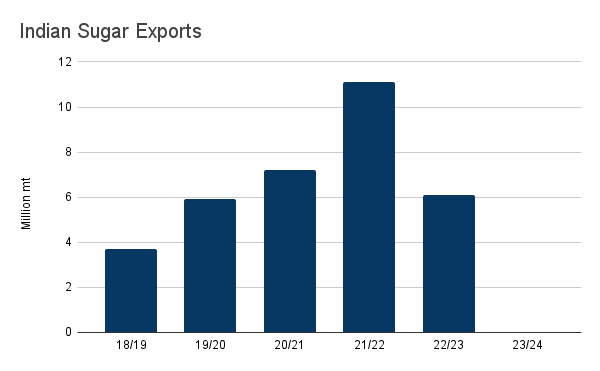India Set to Ban Sugar Exports for the First Time in Seven Years in 2023/24

Monsoon rains in the pivotal cane-growing regions of Maharashtra and Karnataka, which collectively contribute over 50% of India's total sugar production, have remained alarmingly deficient this year, with recorded levels falling as much as 50% below the annual average, as per meteorological data. These erratic rainfall patterns could significantly curtail sugar output for the 2023/24 season, impeding planting preparations for the following 2024/25 season. India’s sugar production could drop to 31.7 million metric tons (mmt) in the 2023/24 season, 3.3% lower than the previous season, according to the Indian government. As a result, it is expected that sugar stocks will not suffice to allocate export quotas.
Consequently, India is poised to institute a ban on sugar mills exporting their produce in the upcoming season, commencing in October. This move marks a halt to shipments for the first time in seven years. According to the Indian Government, precedence will be given to the nation's priority of meeting domestic sugar requirements while maximizing ethanol production from surplus sugarcane. This decision follows export restrictions placed during the 2022/23 season, wherein India permitted mills to export only 6.1 mmt of sugar until September 30, following the unprecedented allowance of selling a record-breaking 11.1 mmt in the previous season.

Source: All India Sugar Trade Association (AISTA)
The prospective absence of India from the global sugar market is likely to exert upward pressure on benchmark prices in New York and London, markets already grappling with multi-year highs. These market dynamics raise concerns of exacerbated inflation in the global food sector. Notably, local sugar prices have surged this week to levels unseen in nearly two years, prompting the government to authorize mills to sell an additional 200,000 mt in August. On August 28, the Oct NY world sugar #11 (SBV23) closed at USc 25.57, up % compared to USc 23.92 on July 28, and a 2-month high, as the market anticipated confirmation from the Indian government regarding the sugar export ban for the coming season. This price surge corresponds with a significant rise in retail inflation in India, which soared to a 15-month peak of 7.44% in July, with food inflation surging to 11.5% — its highest rate in over three years.
Moreover, the prohibition on Indian sugar exports offers a favorable outlook for rival nations like Brazil and Thailand, affording them a promising opening to expand their market dominance. The Center for Advanced Studies in Applied Economics (CEPEA) affirmed that Brazilian sugarcane harvest has displayed commendable progress, thereby bolstering the prospect of increased exports. Simultaneously, Thailand's sugar exports are poised to maintain an upward trajectory, building upon the 125% surge achieved over the last biennium in 2022/23.
In conclusion, deficient monsoon rains in India's key cane-growing regions threaten its sugar production, likely prompting a ban on exports to prioritize domestic needs. This move could elevate global sugar prices and inflation concerns. Much attention will undoubtedly be focused on weather developments in India, which will determine any further legislation taken by the government. According to India's weather bureau, the state of Maharashtra, which accounts for 37% of India's sugar output, has received as much as 20% less rain than normal since the start of the season. According to India's food ministry, a final decision about sugar exports for 2023/24 is expected when actual estimates of total production are available.





